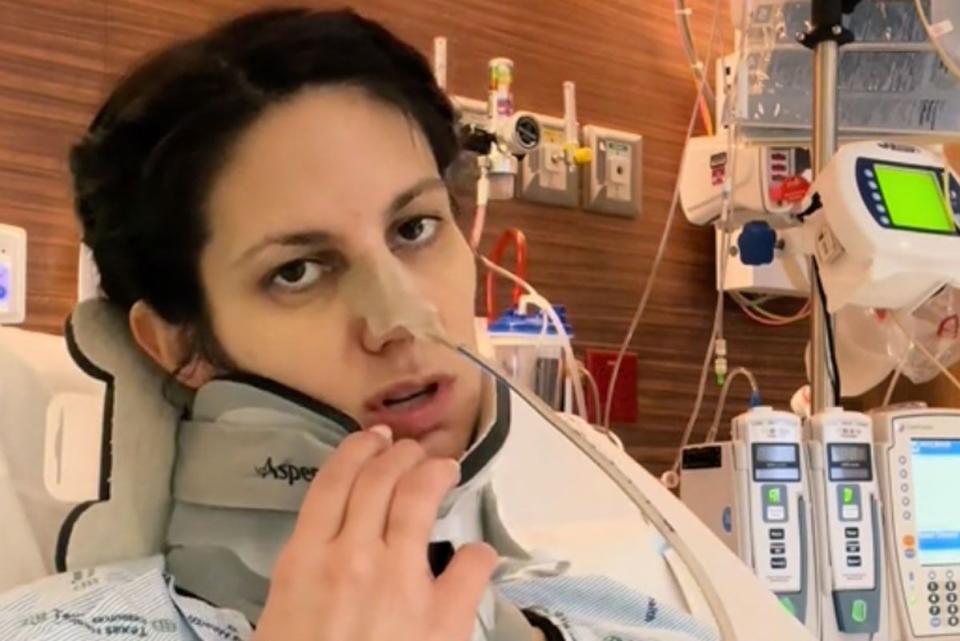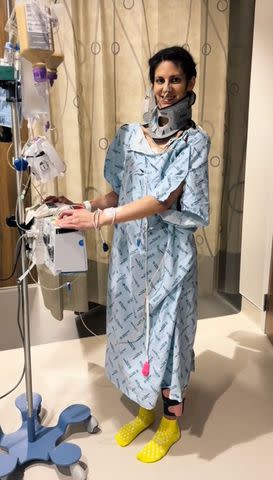Woman, 35, Becomes Partially Paralyzed After Getting Botox Injections for Her Migraines: 'Horrifying and Scary' (Exclusive)
"The muscles in my neck are essentially paralyzed, preventing me from lifting my head," Alicia Hallock said from the ICU

Alicia Hallock
Alicia HallockAlicia Hallock, known as @alihallock on TikTok and Instagram, shared a frightening health experience on social media that landed her in the ICU.
"I experienced a rare complication from my Botox injections for migraines," the 35-year-old wrote on Instagram. "It spread to muscles in my neck, causing various issues. My eyelids are droopy, leading to significant pressure, blurry vision, and dizziness."
She continued, "The muscles in my neck are essentially paralyzed, preventing me from lifting my head. I must wear a neck brace to support my head upright; otherwise, I'm unable to stabilize it. Additionally, I've developed dysphagia [difficulty swallowing], which has been the most alarming aspect of this ordeal. There have been moments where I've choked on sips of water and even my saliva."
"My speech is greatly affected. It's slurred and hoarse. A speech therapist is assisting to retrain my muscles and assess my vocal cords," she added.
According to the American Migraine Foundation, Botox is an FDA-approved treatment for chronic migraines, defined as headaches occurring 15 or more days per month. The procedure involves injecting Botox into the muscles around the face, head and neck to interrupt pain pathways.
But if the toxin in the product spreads beyond the intended treatment site, it can cause botulism, a condition that can lead to progressive muscle paralysis, according to the FDA.
A few days after Hallock's initial post, she took to Instagram again to share an update with her followers, saying she'd temporarily stopped breathing after mucus got stuck in her throat.
"They had to bag me to bring my oxygen levels back up and to keep me from blacking out. It was super scary. I’m relatively okay now, but I am on oxygen. I’ve had a few less severe episodes since then," she wrote.
"They gave me the botulism anti toxin yesterday that was sent here from the CDC, we’ll see how things look today and decide if they want to do a second dose or not. It won’t actually reverse anything that’s already bonded to the muscle, but it can prevent things from getting worse," she added, explaining how doctors are giving her medication through feeding tubes.
Related: How to Migraine-Proof Your Life
But in her most recent TikTok video from the hospital, she expressed feeling more "scared and horrified" than ever. In the video, she takes off her neck brace to show people how she's unable to hold up her head by herself.
"I know it’s a little scary and daunting to see, and I’m sure none of you expected this to be my reality, even with what I’ve shared here so far," she captioned the video. "So, I apologize. But, this is where I’m currently at. And I just wanted to show you my wibbly-wobbly bobble head, and let everyone know I am fighting and I am doing okay at the moment."
Related: Khloé Kardashian Says She Skipped 2024 People's Choice Awards Due to 'Extreme Migraine'
Never miss a story — sign up for PEOPLE's free daily newsletter to stay up-to-date on the best of what PEOPLE has to offer, from celebrity news to compelling human interest stories.
Since sharing her story, people have taken to the comments on her social media to share positive thoughts for Hallock.
"Oh my god, you are so amazing I’m so proud of you and sending constant prayers," one user commented on her recent Instagram post.
"We love you Ali!!! Hang in there xoxo," someone else wrote.

Alicia Hallock
Alicia HallockSpeaking to PEOPLE on Tuesday, Hallock's husband Brian shared how in total his wife was in the hospital for 18 days.
"She just got cleared to come home today," he says. "She has a feeding tube placed directly in her stomach called a peg tube that she'll continue to be fed through for the next 8-12 weeks or until her symptoms resolve enough for her to be able to eat on her own."
"She'll continue to have home health nurses to come help her with various things here at home, including a dietician, speech therapist and when the time is right, occupation and physical therapists as well," he added.
For more People news, make sure to sign up for our newsletter!
Read the original article on People.

